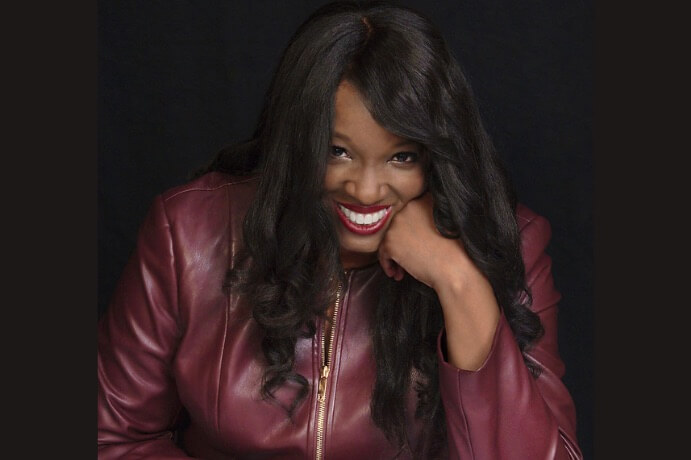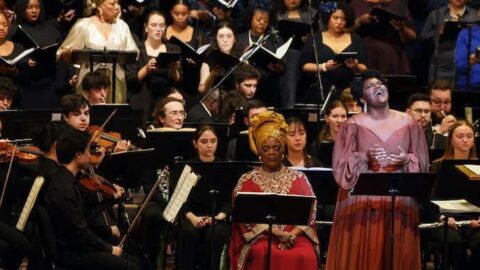The stage at the University of Michigan’s Hill Auditorium was jam-packed with an assembly of celebrity soloists and student ensembles for the Feb. 10 world premiere of When the Caged Bird Sings by composer and lyricist Nkeiru Okoye. Drawing inspiration from the Black church, the work is a resplendent celebration of triumph in the face of adversity, the nurturing strength of community, and the profound transformative power wielded by Black women throughout history.
With a cool command of the massive array of performers on stage, Okoye’s writing joyfully danced from gospel music and spirituals to operatic solos, from cinematic orchestral interludes to minimalist riffs, and from electrifying ostinatos to lilting spoken word. Through all of this, the featured soloists and ensembles delivered an articulate and colorful performance that transported listeners to a dreamlike space somewhere between musical theater, oratorio, and opera.
When the Caged Bird Sings is the fourth commission by the University of Michigan School of Music, Theatre & Dance as part of its Michigan Orchestra Repertoire for Equity initiative (MORE). Kenneth Kiesler, director of university orchestras and professor of conducting, established MORE in 2020 to commission, premiere, and record 10 new orchestral works in 10 years with the intention of diversifying the symphonic repertoire.
The premiere featured an all-star lineup including narrator Rita Coburn, soprano Angela Brown, alto Christie Dashiell, tenor Issachah Savage, baritone Jubilant Sykes, and pianist Cyrus Chestnut. Supporting them were the University Symphony Orchestra led by Kiesler, as well as the University Choirs and EXIGENCE Vocal Ensemble, directed by Eugene Rogers.

In an interview about the piece, Okoye describes When the Caged Bird Sings as “a musical ceremony,” one that explores ritual in the context of both concert and community. A native New Yorker of African American and Nigerian descent, Okoye says she wrote When the Caged Bird Sings as an examination of “Black women and how we are portrayed.”
The work centers on a young Black girl named Cerise (played by Dashiell), who defies all stereotypes and is “just a girl who grew up.” Okoye’s narrative unfolds across a series of operatic arias for Cerise, her mother (Brown), her father (Sykes), and her guidance counselor (Savage), as well as through interjections by an omniscient narrator (Coburn). Over the work’s five parts – each titled after a Maya Angelou book or poem – we bear witness to Cerise’s search for meaning as she asks the question, “Who am I supposed to be, in a world that cannot see anything good for little girls who look like me?”
Cerise’s tumultuous journey is foreshadowed by her mother’s conversation with God in “You gave me a baby girl.” Brown’s stunning performance oscillated between tender expressions of unconditional love for her daughter-to-be and outright fear at the prospect of bringing a baby girl into a world rife with racism. Okoye burnishes the scene with great emotional depth and nuance, which was further illuminated by Brown’s virtuosic and heartfelt performance.
After Cerise is sent home from school (not for misbehaving, but because of the braids in her hair), her father has his own moment of reckoning in “I thought this life would protect us” as he realizes he can never fully safeguard his family. Sykes’ powerful and rapturous performance juxtaposed his unwavering love for his family with his outrage at the racist acts that have profoundly shaped their lives.

As she grows into adolescence, Cerise faces persistent bullying and an eventual personal crisis, which is recounted by her guidance counselor. As the narrative builds to a crescendo, so does the music, with a tense, rhythmic ostinato spurred on by fragments of the Dies Irae (“The Day of Wrath”), the perennial and iconic motif from the medieval funeral mass. In one of the show’s stand-out sequences, Savage grapples with his morally questionable intervention on Cerise’s behalf with a booming and incisive voice in “It takes a village to raise a child.”
At different times in When the Caged Bird Sings, we see people have conversations with God, and in turn we see God responding through the actions of his people; we see a community united by faith and driven to action; and we see a persistent spirit of hope from which resilience grows. Interjected in the central drama that played out with the soloists at the front of the stage, Coburn’s performance as the narrator provided commentary by way of poetic sermons that were soulfully echoed by the sensational EXIGENCE Vocal Ensemble (acting as congregants) and accompanied by Chestnut’s eloquent pianism. Coburn’s impassioned performance drove straight to the heart with empowering affirmations and calls to action that channeled the unwavering strength, wisdom, and vision of Black women past and present.
For all its dark moments, When the Caged Bird Sings is ultimately a work about hope and transcendence. Cerise’s story came to a close in the final section, “A Song Flung Up to Heaven,” as Dashiell’s velvet vocals ascended to a rousing number that dually celebrated Cerise’s triumphs while honoring the hardships she faced. A minimalist flute motive emerged a few times in the final scenes, fluttering gently like a butterfly, symbolizing Cerise’s transformation. Shimmering in her opalescent dress, Coburn delivered a final benediction to both Cerise and the audience: “May he instill in you the spirit of transformation … be transformed by the renewing of your life!”
I CARE IF YOU LISTEN is an editorially-independent program of the American Composers Forum, funded with generous donor and institutional support. Opinions expressed are solely those of the author and may not represent the views of ICIYL or ACF.
A gift to ACF helps support the work of ICIYL. For more on ACF, visit the “At ACF” section or composersforum.org.
























